Potential Use of Rendering Mortar Waste Powder as a Cement Replacement Material: Fresh, Mechanical, Durability and Microstructural Properties
Abstract
:1. Introduction
2. Materials and Methods
2.1. Cement
2.1.1. Fine Aggregate
2.1.2. Rendering Mortar Waste Powder (RMWP)
2.1.3. Water
2.1.4. Superplasticizer
2.2. Mix Proportions
2.3. Mixing and Curing Procedures
2.4. Experimental Tests
2.4.1. Flow Rate
2.4.2. Compressive Strength
2.4.3. Flexural Strength
2.4.4. Water Absorption and Bulk Density
2.4.5. Ultrasonic Pulse Velocity and Dynamic Elastic Modulus
2.4.6. Electrical Resistivity
- L: The height of the specimen in cm.
- A: The cross-sectional area of the specimen (in cm2).
- R: The impedance.
- ER: The electrical resistivity (Ω·cm).
2.4.7. Microstructure Studies
2.4.8. Life Cycle Assessment (LCA)
- The final target is the production of 1 m3 of mortar.
- The 100-year Global Warming Potential (GWP) of mortars with different content of RMWP was calculated.
- In this research, the normalization approach was used as not all the mixtures have the same compressive strength. The normalization was performed based on the GWP impact per MPa of the compressive strength of the mortar at 28 days and 56 days.
3. Results and Discussions
3.1. Flow Rate
3.2. Compressive Strength
3.3. Flexural Strength
3.4. Bulk Density
3.5. Ultrasonic Pulse Velocity
3.6. Dynamic Modulus of Elasticity
3.7. Electrical Resistivity
3.8. Water Absorption
3.9. Microstructural Analysis
3.10. Life Cycle Assessment (LCA) Results
4. Conclusions
- At replacement ratios of less than 10% and greater than 20%, the RMWP enhanced the fresh mortar’s flowability marginally, while at 15% content, it decreased it by 7%.
- The RMWP caused a decline in the compressive strength of the mortar. However, the decrease in strength was partially recovered after 56 days compared to 28 days. The lowest reduction in compressive strength was recorded for the RMWP15 mixture, 17.47% lower than the reference mortar.
- The partial recovery of compressive strength after 56 compared to the 28 days gives the impression of the possibility of greater strength improvement (greater recovery) over time. However, a comprehensive study that includes late ages, such as 180 days or longer, is recommended to verify this.
- In terms of flexural strength, up to 15%, it was almost unaffected by RMWP use. After that, however, the strength dropped with the rise of the RMWP content.
- The replacement of cement with RMWP resulted in a decrease in ultrasonic pulse velocity, bulk density, and dynamic modulus of elasticity. Among the RMWP variations, RMWP15 showed the lowest decreasing rates of 4.09%, 4.13%, and 11.85%, respectively.
- At a low content of RMWP (10%), the electrical resistance decreased, but it was the same as the reference mixture at RMWP15. However, for higher replacement ratios, it improved by 6.50 to 12.84%.
- Water absorption levels are comparable (or slightly lower) to the control sample, up to a 15% RMWP residue. However, at a 20% or higher ratio, the absorption increases proportionally with the RMWP content.
- The use of RMWP in place of cement at a ratio of 15% densified the microstructure of the mortar and made it more homogenous compared to plain mortar.
- Replacing the cement partially with RMWP resulted in a reduction in the GWP of mortars.
- When the compressive strength (MPa) of mortars was used in the calculation of the optimum mixtures, results indicated that mortar with 15% RMWP provided the lowest GWP per MPa.
- In summary, to promote sustainability, it is possible to use RMWP as a substitute for cement at a rate of 15% with approximately a 17% reduction in compressive strength and an equal or slight improvement in durability properties to produce eco-friendly mortar.
Author Contributions
Funding
Institutional Review Board Statement
Informed Consent Statement
Data Availability Statement
Conflicts of Interest
References
- Hamad, M.A.; Nasr, M.; Shubbar, A.; Al-Khafaji, Z.; Al Masoodi, Z.; Al-Hashimi, O.; Kot, P.; Alkhaddar, R.; Hashim, K. Production of Ultra-High-Performance Concrete with Low Energy Consumption and Carbon Footprint Using Supplementary Cementitious Materials Instead of Silica Fume: A Review. Energies 2021, 14, 8291. [Google Scholar]
- de Andrade Salgado, F.; de Andrade Silva, F. Recycled aggregates from construction and demolition waste towards an application on structural concrete: A review. J. Build. Eng. 2022, 52, 104452. [Google Scholar] [CrossRef]
- Abadel, A.A.; Alghamdi, H. Effect of high volume tile ceramic wastes on resistance of geopolymer mortars to abrasion and freezing-thawing cycles: Experimental and deep learning modelling. Ceram. Int. 2023, 49, 15065–15081. [Google Scholar] [CrossRef]
- Eurostat. Waste Statistics in Europe; Eurostat: Luxembourg, 2019. [Google Scholar]
- Vaishnavi Devi, S.; Gausikan, R.; Chithambaranathan, S.; Wilfred Jeffrey, J. Utilization of recycled aggregate of construction and demolition waste as a sustainable material. Mater. Today Proc. 2021, 45, 6649–6654. [Google Scholar] [CrossRef]
- Colangelo, F.; Cioffi, R. Mechanical properties and durability of mortar containing fine fraction of demolition wastes produced by selective demolition in South Italy. Compos. Part B Eng. 2017, 115, 43–50. [Google Scholar] [CrossRef]
- Villoria Sáez, P.; Osmani, M. A diagnosis of construction and demolition waste generation and recovery practice in the European Union. J. Clean. Prod. 2019, 241, 118400. [Google Scholar] [CrossRef]
- Ginga, C.; Ongpeng, J. materials Circular Economy on Construction and Demolition Waste: A Literature Review on Material Recovery and Production. Materials 2020, 13, 2970. [Google Scholar] [CrossRef]
- Wang, X.; Yu, R.; Shui, Z.; Song, Q.; Liu, Z.; Bao, M.; Liu, Z.; Wu, S. Optimized treatment of recycled construction and demolition waste in developing sustainable ultra-high performance concrete. J. Clean. Prod. 2019, 221, 805–816. [Google Scholar] [CrossRef]
- Infante Gomes, R.; Brazão Farinha, C.; Veiga, R.; de Brito, J.; Faria, P.; Bastos, D. CO2 sequestration by construction and demolition waste aggregates and effect on mortars and concrete performance—An overview. Renew. Sustain. Energy Rev. 2021, 152, 111668. [Google Scholar] [CrossRef]
- Degirmenci, N.; Yilmaz, A.; Cakir, O.A. Utilization of waste glass as sand replacement in cement mortar. Indian J. Eng. Mater. Sci. 2011, 18, 303–308. [Google Scholar]
- John, S.K.; Nadir, Y.; Girija, K. Effect of source materials, additives on the mechanical properties and durability of fly ash and fly ash-slag geopolymer mortar: A review. Constr. Build. Mater. 2021, 280, 122443. [Google Scholar] [CrossRef]
- Ribeiro, M.C.S.; Fiúza, A.; Castro, A.C.M.; Silva, F.G.; Dinis, M.L.; Meixedo, J.P.; Alvim, M.R. Mix design process of polyester polymer mortars modified with recycled GFRP waste materials. Compos. Struct. 2013, 105, 300–310. [Google Scholar]
- Henao Rios, L.M.; Hoyos Triviño, A.F.; Villaquirán-Caicedo, M.A.; de Gutiérrez, R.M. Effect of the use of waste glass (as precursor, and alkali activator) in the manufacture of geopolymer rendering mortars and architectural tiles. Constr. Build. Mater. 2023, 363, 129760. [Google Scholar] [CrossRef]
- Jesus, S.; Maia, C.; Brazão Farinha, C.; de Brito, J.; Veiga, R. Rendering mortars with incorporation of very fine aggregates from construction and demolition waste. Constr. Build. Mater. 2019, 229, 116844. [Google Scholar] [CrossRef]
- Pahlavan, P.; Manzi, S.; Rodriguez-Estrada, M.T.; Bignozzi, M.C. Valorization of spent cooking oils in hydrophobic waste-based lime mortars for restorative rendering applications. Constr. Build. Mater. 2017, 146, 199–209. [Google Scholar] [CrossRef]
- Lanzón, M.; Cnudde, V.; De Kock, T.; Dewanckele, J. Microstructural examination and potential application of rendering mortars made of tire rubber and expanded polystyrene wastes. Constr. Build. Mater. 2015, 94, 817–825. [Google Scholar] [CrossRef]
- Silva, R.V.; De Brito, J.; Dhir, R.K. Performance of cementitious renderings and masonry mortars containing recycled aggregates from construction and demolition wastes. Constr. Build. Mater. 2016, 105, 400–415. [Google Scholar]
- Ruviaro, A.S.; Silvestro, L.; Pelisser, F.; de Azevedo, A.R.G.; de Matos, P.R.; Gastaldini, A.L.G. Long-term effect of recycled aggregate on microstructure, mechanical properties, and CO2 sequestration of rendering mortars. Constr. Build. Mater. 2022, 321, 126357. [Google Scholar] [CrossRef]
- Hassan, A.M.S.; Shoukry, H.; Perumal, P.; Abd El-razik, M.M.; Aly, R.M.H.; Alzahrani, A.M.Y. Evaluation of the thermo-physical, mechanical, and fire resistance performances of limestone calcined clay cement (LC3)-based lightweight rendering mortars. J. Build. Eng. 2023, 71, 106495. [Google Scholar] [CrossRef]
- Alghamdi, H.; Shoukry, H.; Abadel, A.A.; Khawaji, M. Performance assessment of limestone calcined clay cement (LC3)-Based lightweight green mortars incorporating recycled waste aggregate. J. Mater. Res. Technol. 2023, 23, 2065–2074. [Google Scholar] [CrossRef]
- Nenevê, B.L.; Costa, M.R.M.M.; Medeiros-Junior, R.A. Alternative small-scale accelerated test to measure the effect of thermal shock on rendering mortar properties. J. Build. Eng. 2022, 46, 103807. [Google Scholar] [CrossRef]
- De Souza Kazmierczak, C.; Dutra Schneider, S.; Aguilera, O.; Albert, C.C.; Mancio, M. Rendering mortars with crumb rubber: Mechanical strength, thermal and fire properties and durability behaviour. Constr. Build. Mater. 2020, 253, 119002. [Google Scholar] [CrossRef]
- Stefanidou, M.; Pachta, V.; Konstantinidis, G. Exploitation of waste perlite products in lime-based mortars and grouts. Sustain. Chem. Pharm. 2023, 32, 101024. [Google Scholar] [CrossRef]
- Abadel, A.A.; Alghamdi, H.; Alharbi, Y.R.; Alamri, M.; Khawaji, M.; Abdulaziz, M.A.M.; Nehdi, M.L. Investigation of Alkali-Activated Slag-Based Composite Incorporating Dehydrated Cement Powder and Red Mud. Materials 2023, 16, 1551. [Google Scholar] [CrossRef]
- Farinha, C.B.; de Brito, J.; Veiga, R. Assessment of glass fibre reinforced polymer waste reuse as filler in mortars. J. Clean. Prod. 2019, 210, 1579–1594. [Google Scholar] [CrossRef]
- Miranda, L.F.R.; Selmo, S.M.S. CDW recycled aggregate renderings: Part I—Analysis of the effect of materials finer than 75 μm on mortar properties. Constr. Build. Mater. 2006, 20, 615–624. [Google Scholar] [CrossRef]
- Farinha, C.; de Brito, J.; Veiga, R. Incorporation of fine sanitary ware aggregates in coating mortars. Constr. Build. Mater. 2015, 83, 194–206. [Google Scholar] [CrossRef]
- Oliveira, R.; de Brito, J.; Veiga, R. Incorporation of fine glass aggregates in renderings. Constr. Build. Mater. 2013, 44, 329–341. [Google Scholar] [CrossRef]
- Braga, M.; de Brito, J.; Veiga, R. Incorporation of fine concrete aggregates in mortars. Constr. Build. Mater. 2012, 36, 960–968. [Google Scholar] [CrossRef]
- Garg, N.; Shrivastava, S. A review on utilization of recycled concrete aggregates (RCA) and ceramic fines in mortar application. Mater. Today Proc. 2023, 73, 64–73. [Google Scholar] [CrossRef]
- Ayat, A.; Bouzerd, H.; Ali-Boucetta, T.; Navarro, A.; Benmalek, M.L. Valorisation of waste glass powder and brick dust in air-lime mortars for restoration of historical buildings: Case study theatre of Skikda (Northern Algeria). Constr. Build. Mater. 2022, 315, 125681. [Google Scholar] [CrossRef]
- Oliveira, R.; de Brito, J.; Veiga, R. Reduction of the cement content in rendering mortars with fine glass aggregates. J. Clean. Prod. 2015, 95, 75–88. [Google Scholar] [CrossRef]
- Brazão Farinha, C.; de Brito, J.; Veiga, R. Incorporation of high contents of textile, acrylic and glass waste fibres in cement-based mortars. Influence on mortars’ fresh, mechanical and deformability behaviour. Constr. Build. Mater. 2021, 303, 124424. [Google Scholar] [CrossRef]
- Lucas, J.; de Brito, J.; Veiga, R.; Farinha, C. The effect of using sanitary ware as aggregates on rendering mortars’ performance. Mater. Des. 2016, 91, 155–164. [Google Scholar] [CrossRef]
- Xiao, J.; Ma, Z.; Sui, T.; Akbarnezhad, A.; Duan, Z. Mechanical properties of concrete mixed with recycled powder produced from construction and demolition waste. J. Clean. Prod. 2018, 188, 720–731. [Google Scholar] [CrossRef]
- Chen, X.; Li, Y.; Bai, H.; Ma, L. Utilization of recycled concrete powder in cement composite: Strength, microstructure and hydration characteristics. J. Renew. Mater. 2021, 9, 2189. [Google Scholar] [CrossRef]
- Nasr, M.S.; Salman, A.J.; Ghayyib, R.J.; Shubbar, A.; Al-Mamoori, S.; Al-khafaji, Z.; Hashim, T.M.; Hasan, Z.A.; Sadique, M. Effect of Clay Brick Waste Powder on the Fresh and Hardened Properties of Self-Compacting Concrete: State-of-the-Art and Life Cycle Assessment. Energies 2023, 16, 4587. [Google Scholar] [CrossRef]
- Iraqi Standard NO.5; Portland Cement. Central Organization for Standardization and Quality Control: Baghdad, Iraq, 1984.
- Iraqi Standard NO.45; Aggregate from Natural Sources for Concrete and Building Construction. Central Organization for Standardization and Quality Control: Baghdad, Iraq, 1984.
- ASTM C494/C494M; Standard Specification for Chemical Admixtures for Concrete. ASTM International: West Conshohocken, PA, USA, 2013.
- ASTM C109/C109M; Standard Test Method for Compressive Strength of Hydraulic Cement Mortars (Using 2-in. or [50-mm] Cube Specimens). ASTM International: West Conshohocken, PA, USA, 2013.
- ASTM C1437; Standard Test Method for Flow of Hydraulic Cement Mortar. ASTM International: West Conshohocken, PA, USA, 2013.
- BS EN 196–1; Methods of Testing Cement. Determination of strength. British Standards Institution-BSI and CEN European Committee for Standardization: London, UK, 2005.
- ASTM C642; Standard Test Method for Density, Absorption, and Voids in Hardened Concrete. ASTM International: West Conshohocken, PA, USA, 2013.
- ASTM C597; Standard Test Method for Pulse Velocity through Concrete. ASTM International: West Conshohocken, PA, USA, 2009.
- Gopalakrishnan, R.; Nithiyanantham, S. Microstructural, mechanical, and electrical properties of copper slag admixtured cement mortar. J. Build. Eng. 2020, 31, 101375. [Google Scholar] [CrossRef]
- Rusati, P.K.; Song, K.-I. Magnesium chloride and sulfate attacks on gravel-sand-cement-inorganic binder mixture. Constr. Build. Mater. 2018, 187, 565–571. [Google Scholar] [CrossRef]
- Robayo-Salazar, R.A.; Mejía-Arcila, J.M.; de Gutiérrez, R.M. Eco-efficient alkali-activated cement based on red clay brick wastes suitable for the manufacturing of building materials. J. Clean. Prod. 2017, 166, 242–252. [Google Scholar] [CrossRef]
- Jackiewicz-Rek, W.; Załęgowski, K.; Garbacz, A.; Bissonnette, B. Properties of cement mortars modified with ceramic waste fillers. Procedia Eng. 2015, 108, 681–687. [Google Scholar] [CrossRef] [Green Version]
- Zhu, P.; Mao, X.; Qu, W.; Li, Z.; Ma, Z.J. Investigation of using recycled powder from waste of clay bricks and cement solids in reactive powder concrete. Constr. Build. Mater. 2016, 113, 246–254. [Google Scholar] [CrossRef]
- Ergün, A. Effects of the usage of diatomite and waste marble powder as partial replacement of cement on the mechanical properties of concrete. Constr. Build. Mater. 2011, 25, 806–812. [Google Scholar] [CrossRef]
- Saha, A.K.; Majhi, S.; Sarker, P.K.; Mukherjee, A.; Siddika, A.; Aslani, F.; Zhuge, Y. Non-destructive prediction of strength of concrete made by lightweight recycled aggregates and nickel slag. J. Build. Eng. 2021, 33, 101614. [Google Scholar] [CrossRef]
- Siddique, S.; Jang, J.G. Assessment of molybdenum mine tailings as filler in cement mortar. J. Build. Eng. 2020, 31, 101322. [Google Scholar] [CrossRef]
- Wang, D.; Shi, C.; Farzadnia, N.; Shi, Z.; Jia, H. A review on effects of limestone powder on the properties of concrete. Constr. Build. Mater. 2018, 192, 153–166. [Google Scholar] [CrossRef]
- Nasr, M.S.; Hasan, Z.A.; Jaaz, H.A.G.; Abed, M.K.; Falah, M.W.; Hashim, T.M. Mechanical properties of sustainable reactive powder concrete made with low cement content and high amount of fly ash and silica fume. J. Mech. Behav. Mater. 2022, 31, 617–622. [Google Scholar] [CrossRef]
- Zhang, H.; Ji, T.; He, B.; He, L. Performance of ultra-high performance concrete (UHPC) with cement partially replaced by ground granite powder (GGP) under different curing conditions. Constr. Build. Mater. 2019, 213, 469–482. [Google Scholar] [CrossRef]
- Mashaly, A.O.; Shalaby, B.N.; Rashwan, M.A. Performance of mortar and concrete incorporating granite sludge as cement replacement. Constr. Build. Mater. 2018, 169, 800–818. [Google Scholar] [CrossRef]
- Chowdhury, S.; Mishra, M.; Suganya, O.M. The incorporation of wood waste ash as a partial cement replacement material for making structural grade concrete: An overview. Ain. Shams. Eng. J. 2015, 6, 429–437. [Google Scholar] [CrossRef] [Green Version]
- Mansoor, S.S.; Hama, S.M.; Hamdullah, D.N. Effectiveness of replacing cement partially with waste brick powder in mortar. J. King Saud. Univ. Eng. Sci. 2022; in press. [Google Scholar] [CrossRef]
- Liu, Q.; Li, B.; Xiao, J.; Singh, A. Utilization potential of aerated concrete block powder and clay brick powder from C&D waste. Constr. Build. Mater. 2020, 238, 117721. [Google Scholar] [CrossRef]
- Khelil, N.; Ould Ouali, M.; Meziane, L. On the use of fine dune sand in Reactive Powder Concrete: Effect on resistance, water absorption and UPV properties. Constr. Build. Mater. 2023, 388, 131684. [Google Scholar] [CrossRef]
- Mohseni, E.; Yazdi, M.A.; Miyandehi, B.M.; Zadshir, M.; Ranjbar, M.M. Combined effects of metakaolin, rice husk ash, and polypropylene fiber on the engineering properties and microstructure of mortar. J. Mater. Civ. Eng. 2017, 29, 4017025. [Google Scholar]
- Demirel, S.; Öz, H.Ö.; Güneş, M.; Çiner, F.; Adın, S. Life-cycle assessment (LCA) aspects and strength characteristics of self-compacting mortars (SCMs) incorporating fly ash and waste glass PET. Int. J. Life Cycle Assess. 2019, 24, 1139–1153. [Google Scholar]
- Vijayalakshmi, M.; Sekar, A.S.S. Strength and durability properties of concrete made with granite industry waste. Constr. Build. Mater. 2013, 46, 1–7. [Google Scholar] [CrossRef]
- Mardani-Aghabaglou, A.; Tuyan, M.; Yılmaz, G.; Arıöz, Ö.; Ramyar, K. Effect of different types of superplasticizer on fresh, rheological and strength properties of self-consolidating concrete. Constr. Build. Mater. 2013, 47, 1020–1025. [Google Scholar] [CrossRef]
- Sbartaï, Z.M.; Laurens, S.; Elachachi, S.M.; Payan, C. Concrete properties evaluation by statistical fusion of NDT techniques. Constr. Build. Mater. 2012, 37, 943–950. [Google Scholar] [CrossRef] [Green Version]
- El-Dieb, A.S.; Kanaan, D.M. Ceramic waste powder an alternative cement replacement–Characterization and evaluation. Sustain. Mater. Technol. 2018, 17, e00063. [Google Scholar] [CrossRef]
- Shahroodi, A. Development of Test Methods for Assessment of Concrete Durability for Use in Performance-Based Specifications. Ph.D. Thesis, University of Toronto, Toronto, ON, Canada, 2010. [Google Scholar]
- Jain, A.; Gupta, R.; Chaudhary, S. Performance of self-compacting concrete comprising granite cutting waste as fine aggregate. Constr. Build. Mater. 2019, 221, 539–552. [Google Scholar]
- Zafar, M.S.; Javed, U.; Khushnood, R.A.; Nawaz, A.; Zafar, T. Sustainable incorporation of waste granite dust as partial replacement of sand in autoclave aerated concrete. Constr. Build. Mater. 2020, 250, 118878. [Google Scholar] [CrossRef]
- Gharieb, M.; Rashad, A.M. An initial study of using sugar-beet waste as a cementitious material. Constr. Build. Mater. 2020, 250, 118843. [Google Scholar] [CrossRef]
- Jain, A.; Sharma, N.; Choudhary, R.; Gupta, R.; Chaudhary, S. Utilization of non-metalized plastic bag fibers along with fly ash in concrete. Constr. Build. Mater. 2021, 291, 123329. [Google Scholar] [CrossRef]
- Nasr, M.S.; Shubbar, A.; Hashim, T.M.; Abadel, A.A. Properties of a Low-Carbon Binder-Based Mortar Made with Waste LCD Glass and Waste Rope (Nylon) Fibers. Processes 2023, 11, 1533. [Google Scholar] [CrossRef]
- He, Z.; Han, X.; Zhang, M.; Yuan, Q.; Shi, J.; Zhan, P. A novel development of green UHPC containing waste concrete powder derived from construction and demolition waste. Powder Technol. 2022, 398, 117075. [Google Scholar] [CrossRef]
- Li, L.G.; Huang, Z.H.; Tan, Y.P.; Kwan, A.K.H.; Chen, H.Y. Recycling of marble dust as paste replacement for improving strength, microstructure and eco-friendliness of mortar. J. Clean. Prod. 2019, 210, 55–65. [Google Scholar] [CrossRef]

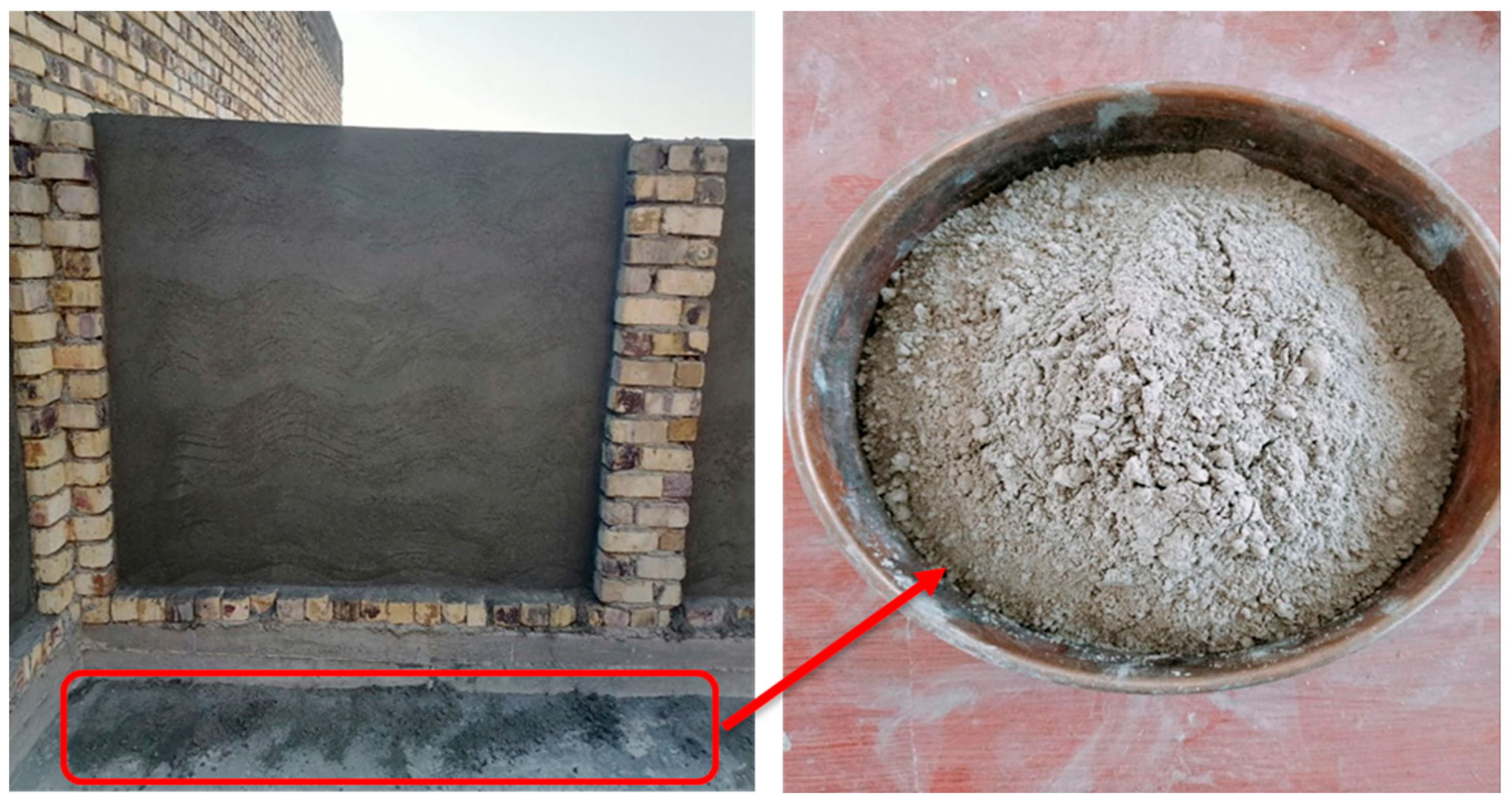
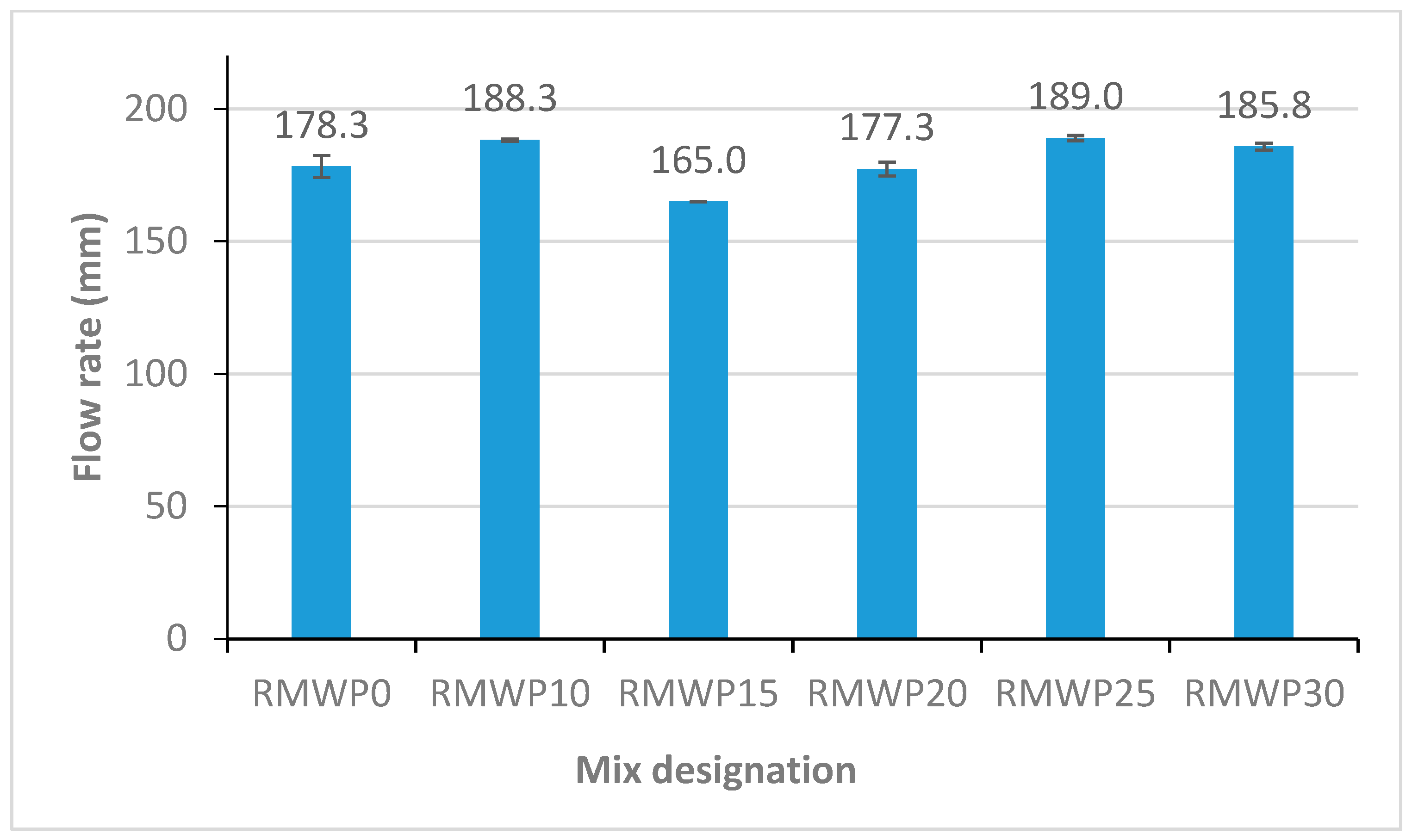


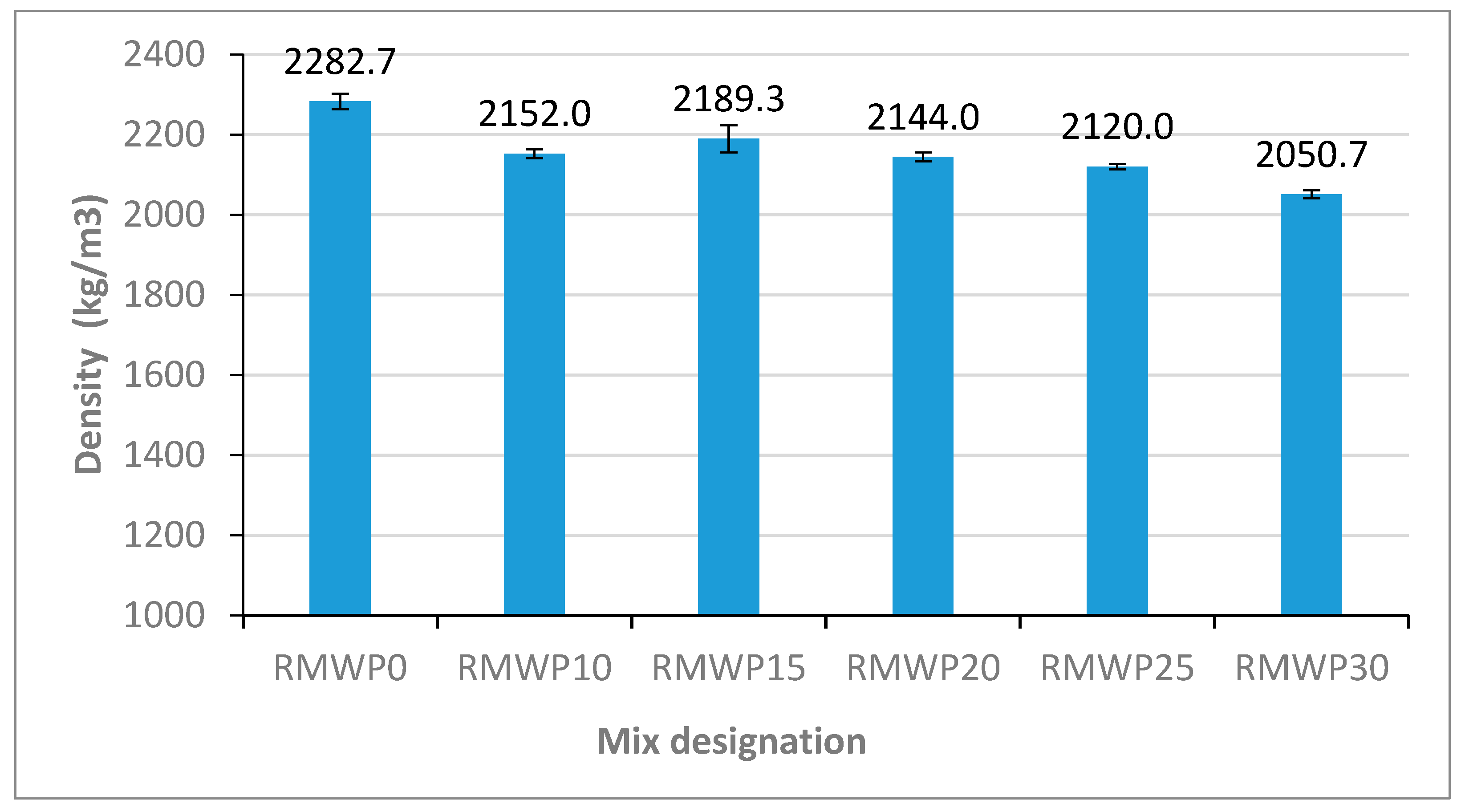


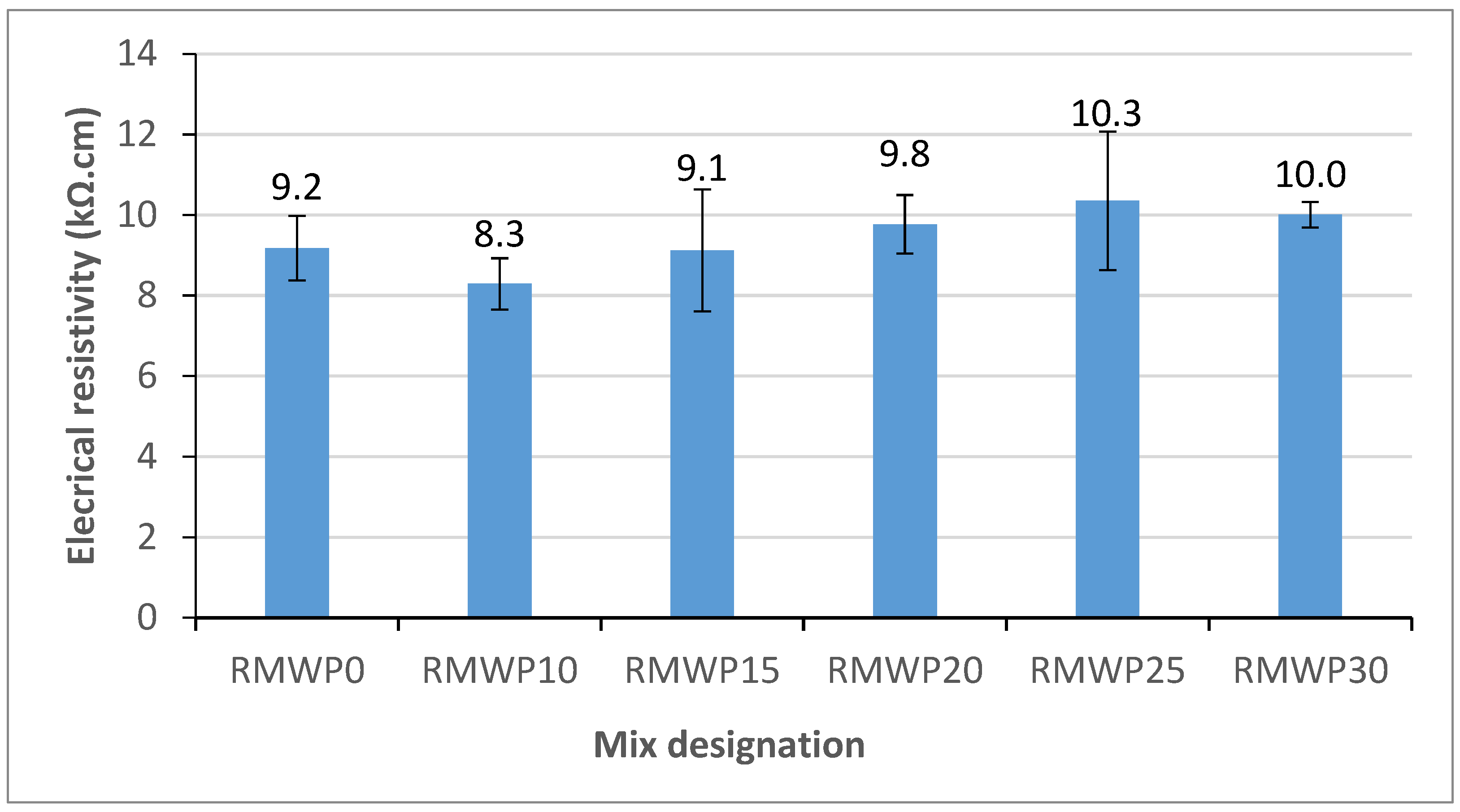
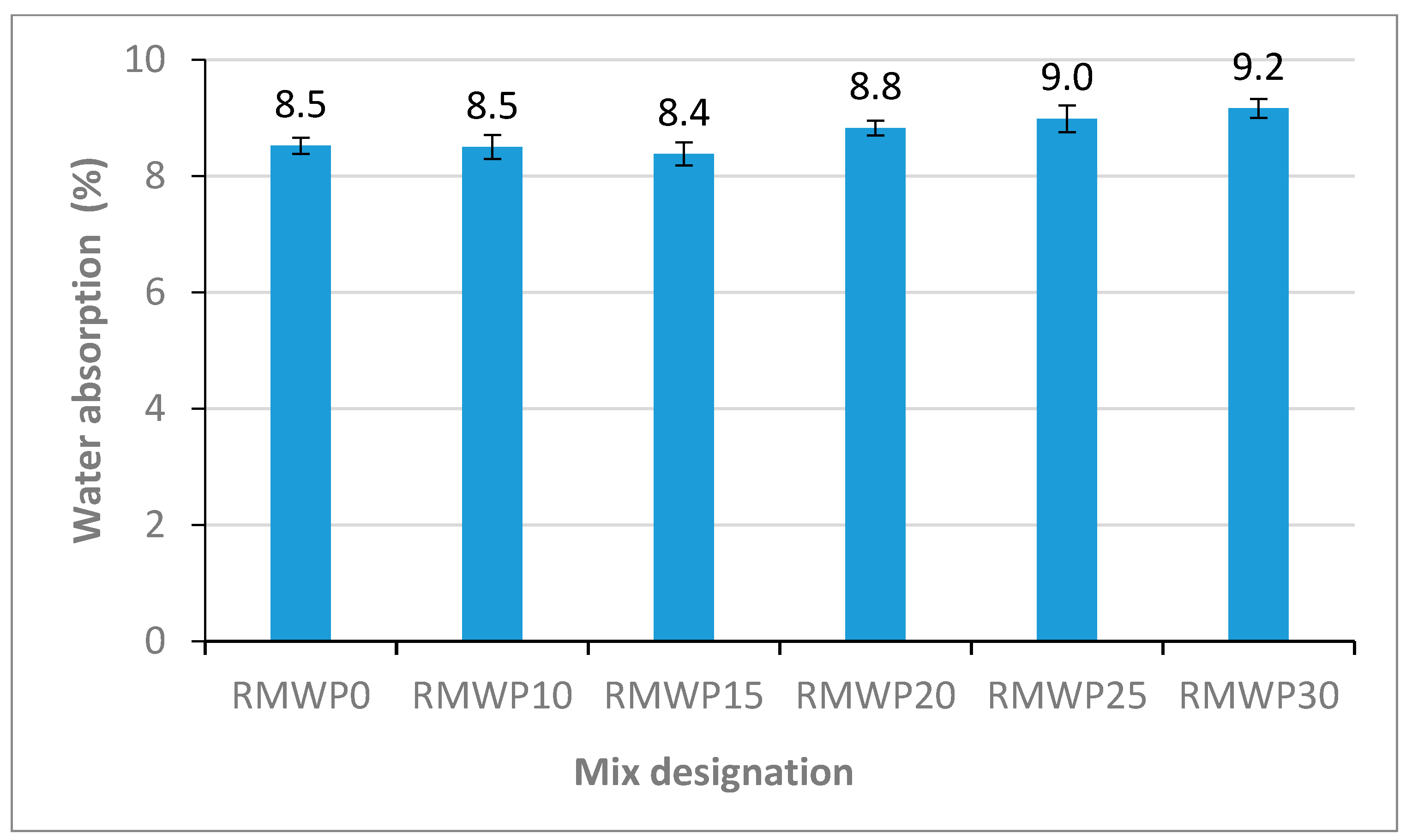
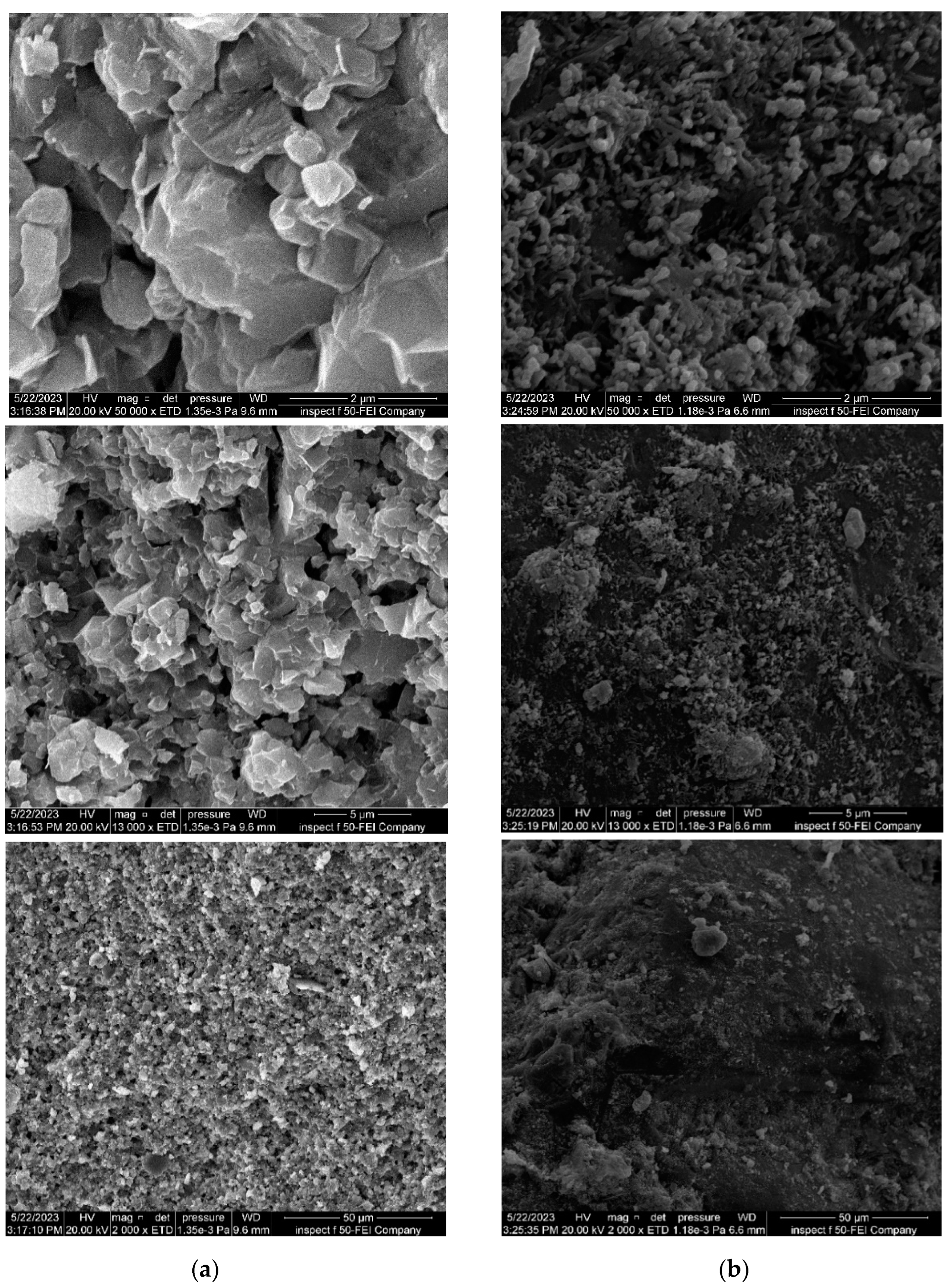
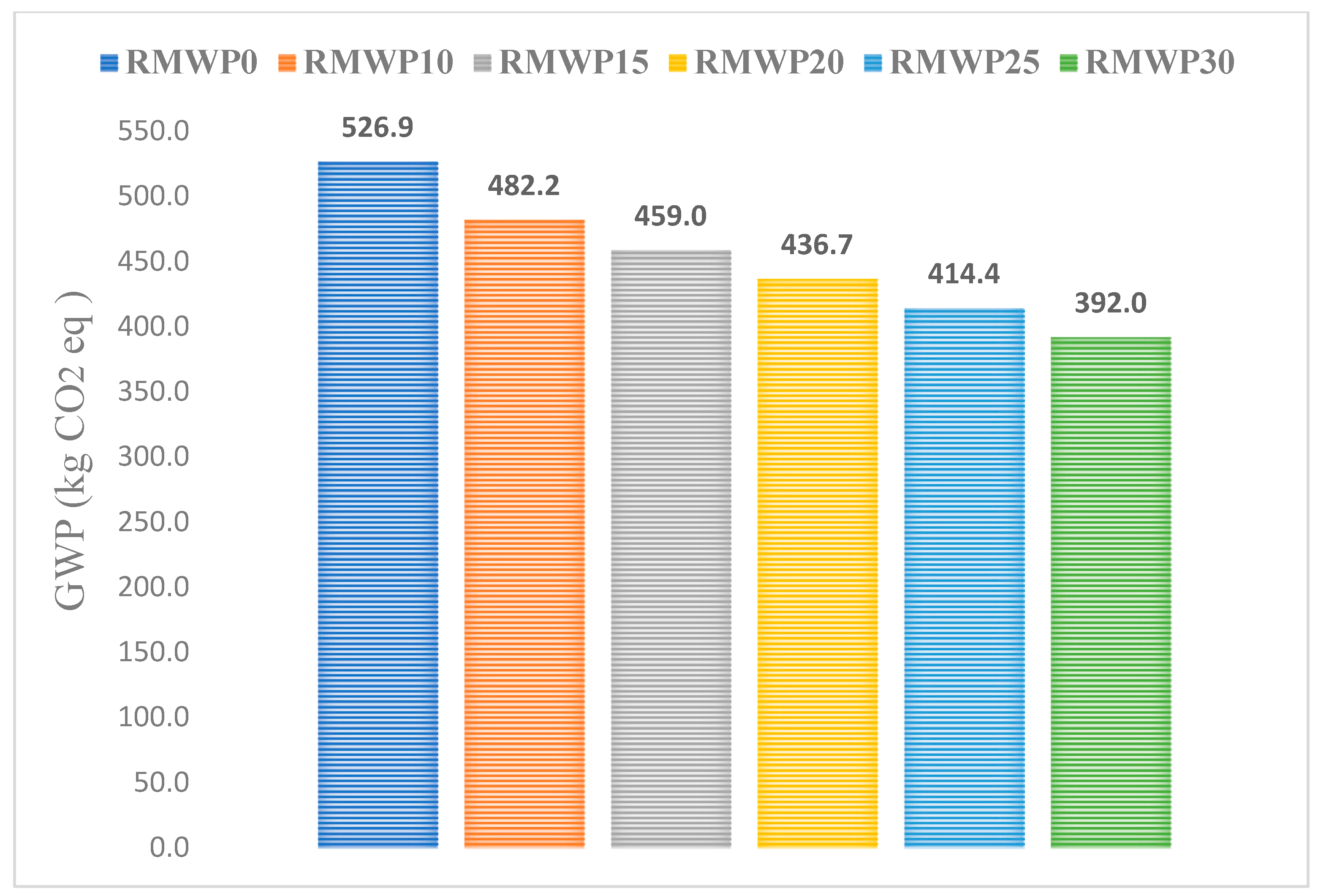
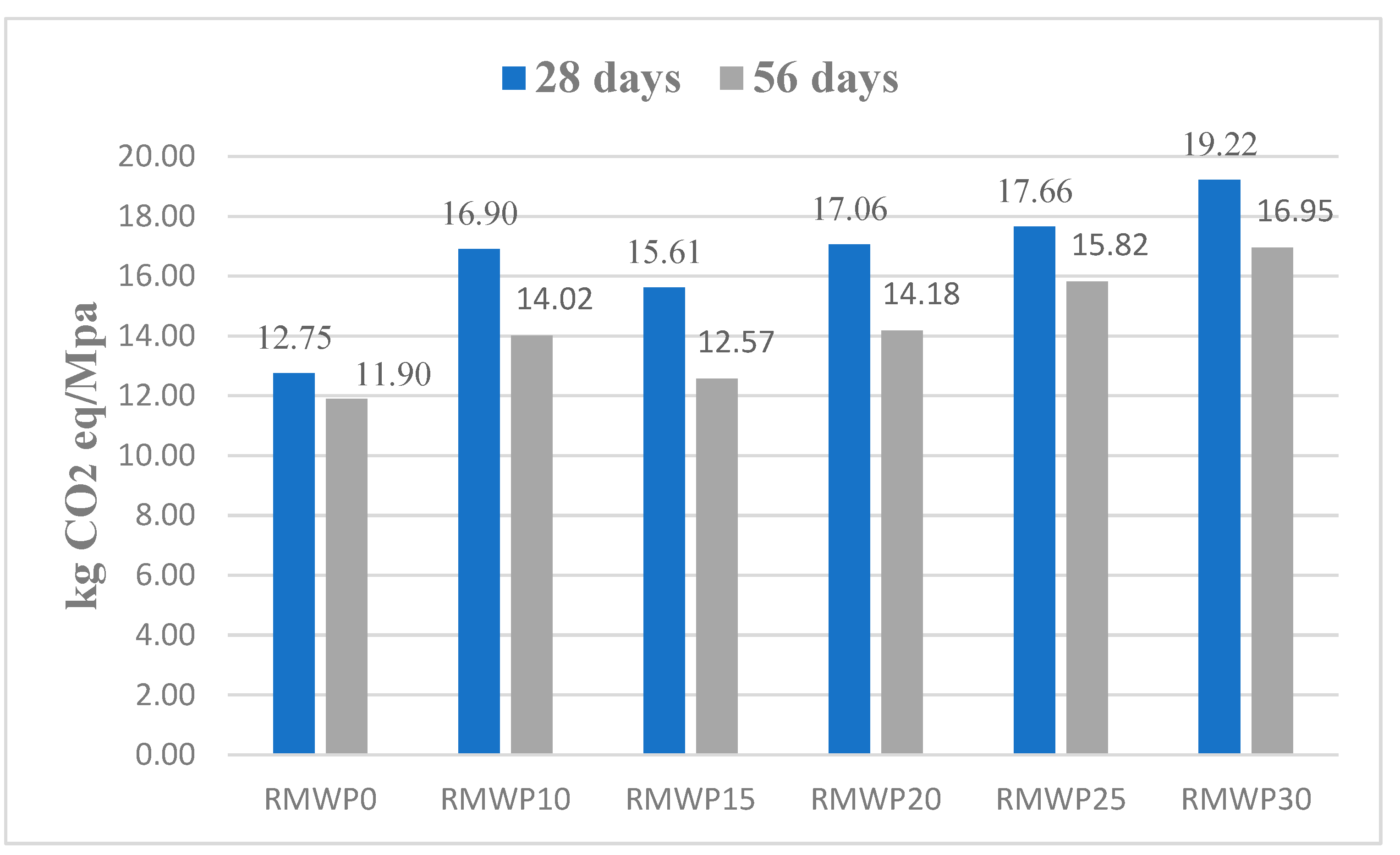
| Oxide | Content, % | |
|---|---|---|
| RMWP | Cement | |
| SiO2 | 49.11 | 16.91 |
| CaO | 20.85 | 60.51 |
| Fe2O3 | 1.387 | 4.360 |
| Al2O3 | 2.475 | 3.194 |
| SO3 | 2.282 | 3.146 |
| MgO | 0.6456 | 2.479 |
| Na2O | 1.227 | 1.429 |
| K2O | 0.892 | 0.495 |
| TiO2 | 0.1244 | --- |
| Sieve Opening (mm) | Accumulative Passing, % | Iraqi Standard Limits |
|---|---|---|
| 4.75 | 94 | 90–100 |
| 2.36 | 82 | 75–100 |
| 1.18 | 69 | 55–90 |
| 0.60 | 43 | 35–59 |
| 0.30 | 12 | 8–30 |
| 0.15 | 1 | 0–10 |
| Mix Designation | Cement | RMWP | Sand | Superplasticizer | Water/Binder |
|---|---|---|---|---|---|
| Control | 1 | 0.0 | 2.75 | 0.007 | 0.45 |
| RMWP10 | 0.90 | 0.10 | 2.75 | 0.007 | 0.45 |
| RMWP15 | 0.85 | 0.15 | 2.75 | 0.007 | 0.45 |
| RMWP20 | 0.80 | 0.20 | 2.75 | 0.007 | 0.45 |
| RMWP25 | 0.75 | 0.25 | 2.75 | 0.007 | 0.45 |
| RMWP30 | 0.70 | 0.30 | 2.75 | 0.007 | 0.45 |
Disclaimer/Publisher’s Note: The statements, opinions and data contained in all publications are solely those of the individual author(s) and contributor(s) and not of MDPI and/or the editor(s). MDPI and/or the editor(s) disclaim responsibility for any injury to people or property resulting from any ideas, methods, instructions or products referred to in the content. |
© 2023 by the authors. Licensee MDPI, Basel, Switzerland. This article is an open access article distributed under the terms and conditions of the Creative Commons Attribution (CC BY) license (https://creativecommons.org/licenses/by/4.0/).
Share and Cite
Abadel, A.A.; Nasr, M.S.; Shubbar, A.; Hashim, T.M.; Tuladhar, R. Potential Use of Rendering Mortar Waste Powder as a Cement Replacement Material: Fresh, Mechanical, Durability and Microstructural Properties. Sustainability 2023, 15, 11659. https://doi.org/10.3390/su151511659
Abadel AA, Nasr MS, Shubbar A, Hashim TM, Tuladhar R. Potential Use of Rendering Mortar Waste Powder as a Cement Replacement Material: Fresh, Mechanical, Durability and Microstructural Properties. Sustainability. 2023; 15(15):11659. https://doi.org/10.3390/su151511659
Chicago/Turabian StyleAbadel, Aref A., Mohammed Salah Nasr, Ali Shubbar, Tameem Mohammed Hashim, and Rabin Tuladhar. 2023. "Potential Use of Rendering Mortar Waste Powder as a Cement Replacement Material: Fresh, Mechanical, Durability and Microstructural Properties" Sustainability 15, no. 15: 11659. https://doi.org/10.3390/su151511659
APA StyleAbadel, A. A., Nasr, M. S., Shubbar, A., Hashim, T. M., & Tuladhar, R. (2023). Potential Use of Rendering Mortar Waste Powder as a Cement Replacement Material: Fresh, Mechanical, Durability and Microstructural Properties. Sustainability, 15(15), 11659. https://doi.org/10.3390/su151511659







